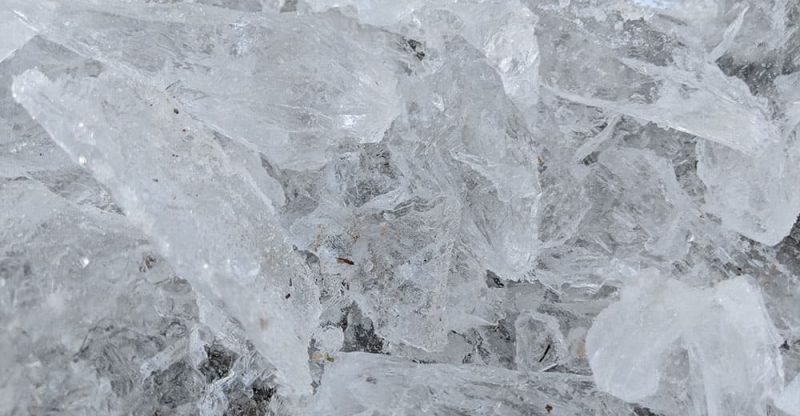What is Aluminum Potassium Sulfate (Potassium Alum) in Food and Deodorant?

Production | Uses | Safety | Side effects
Potassium alum, also known as potassium aluminum sulfate or aluminum potassium sulfate, with chemical formula KAI(SO4)2 and usually present in the dodecahydrate form KAI(SO4)2·12H2O. It is a common type of alum, together with ammonium aluminum sulfate and sodium aluminum sulfate.
This ingredient is mainly used as a deodorant in cosmetics, also can be used in baking powder as a leavening acid with the European food additive number E522.
How is Potassium Alum Made?
Potassium alum has two forms: natural and synthetic types.
The natural one is a rock salt that appears as encrustations on the rock surfaces (alunite) when certain minerals (sulphide and potassium-bearing ones) interact with oxygen. It can be extracted from such natural stones. The crystals are dissolved in water to wash out impurities and follow the process of concentration and drying after extracted.
The synthetic potassium alum can be commercially produced by the reaction of potassium sulfate solution with aluminum sulfate solution, and then upon evaporation to crystallize alum. The following is the chemical reaction equation: Al2(SO4 )3 +3K2SO4 +24H2O =2KAl(SO4)2 ·12H2O
The aluminum sulfate is commonly produced by treating minerals bauxite ore (the main component aluminium oxide) with sulfuric acid. Here is the chemical reaction equation: Al2O3 + 3H2SO4 =Al2(SO4 )3 + 3H2O
Aluminum potassium sulfate anhydrous can be obtained by heating the dodecahydrate form to 200 ℃ to remove the crystal water, but too high temperature will easily produce aluminium oxide.
Property
| Other names | Potash alum |
| CAS number | 7784-24-9 |
| Chemical formula | KAl(SO4)2 (anhydrous), KAl(SO4)2·12H2O (dodecahydrate) |
| Molecular weight | 258.21 (anhydrous), 474.38 (dodecahydrate) |
Appearance
Large, transparent crystals or white crystalline powder with astringent taste.
Solubility
Dodecahydrate is freely soluble in water, while the anhydrous form is slowly soluble in cold water, easily dissolved in hot water. Both types are insoluble in ethanol.
Is potassium aluminum sulfate basic or acidic?
It is a weak acid with the PH between 3.0 and 4.0 (10 % solution). It dissociates Al3+ when dissolved in water and reacts with water to release H+. The following is the reaction equation:
Al3+ + 3H2O — AI(OH)3 + 3H+
What’re the Uses of Potassium Alum?
Potassium alum is a multi-functional ingredient that can be used as a main component in crystal deodorant products, as a food additive in baking powder, as a medical astringent agent to stop the bleeding of small cuts, for water purification, tanning leather and as a mordant in dyeing, and etc.
Food
With the same function of sodium aluminum sulfate but used less than the former, it can be used as a slow-acting leavening acid in baked goods, which reacts with sodium bicarbonate to release carbon dioxide in the condition of oven heat.
It can also be used in pickling to maintain crispness of fruit and vegetables.
Europe limited the uses in food
However, the uses of aluminium sulphate (E520), aluminium sodium sulphate (E521), aluminium potassium sulphate (E522) and aluminium ammonium sulphate (E523) in food are decreasing over time in Europe due to the change in legislation coming into force in February 2014, where the applications are only in two categories: candied cherries and only egg white. (1)
China also restricted its uses
China has banned the use of aluminum compounds – acidic sodium aluminum phosphate, sodium aluminosilicate and aluminum octenyl succinate starch as food additives and aluminum-containing food additives shall not be used in the production of puffed food since July 1, 2014.
Meanwhile, potassium aluminum sulfate and ammonium aluminum sulfate are forbidden to be used in the production of wheat flour and its products (except fried noodle products, batter, breading flour, and frying powder). The alum commonly used in making steamed buns and fried dough sticks was potassium aluminum sulfate.
These two aluminum sulfates were widely used in processing food such as fried food and puffed food in China. However, excessive aluminum may enter into the human body and can cause harm to our health, such as memory loss, mental retardation, movement slowness or even neurological disorders – Alzheimer’s disease.
Japan
Japan’s Ministry of Health, Labor and Welfare (MHLW) has also limited the use of aluminum potassium sulfate and aluminum ammonium sulfate to a maximum use level of 0.1 g (as aluminum) per kg in bread, moist cakes and confections since August 27, 2018. (2)
Medicine
Its pharmaceutical grade has already been used for thousands of years to stop bleeding of small cuts based on its astringent, styptic, soften and healing effects. This property is also utilized in some cosmetics – natural aftershaves.
It can also be used as an antiseptic for wounds, tonsillitis and acne.
Deodorant
Potassium alum is widely used as a main component in crystal deodorant products. It functions as an antibacterial agent that prevents the growth of the bacteria that generates bad odors when we sweat, also acts as an astringent agent that tightens the pores and reduces perspiration (not an antiperspirant that reduces sweat production).
It is an ideal deodorant that can be used in armpits, hands and feet. It is commonly asked if potassium alum deodorant is free of aluminum, it does contain aluminum as there is a low level of aluminum in it.
It can also be used in the formulation of other cosmetics and personal care products, such as aftershave products, skin care products and moisturizers with the ability of inducing a tightening sensation of the skin.
Compare with aluminum chloride/chlorohydrate/zirconium
Potassium alum is a much larger molecule thus hardly absorbed by your skin than usual antiperspirants, such as aluminium chloride, aluminum chlorohydrate and aluminium zirconium, which can pass through the pores and be absorbed by the skin.
Another difference is that these aluminum salts will block sweat ducts and glands, and therefore prevent perspiration by forming a gel in the skin.
Other applications
- Dyeing: a popular mordant to stabilize colours for both animal protein (wool or silk) and cellulose (cotton, linen, hemp) fibers and fabrics.
- Drinking water purification
- Inks
- Leathers
- Tanning
Is Potassium Alum Safe to Eat?
Yes, the safety of aluminum potassium sulfate as a food additive has been approved by authorities, such as the U.S. Food and Drug Administration (FDA), European Food Safety Authority (EFSA), UK Food Standards Agency, as well as the Joint FAO/WHO Expert Committee on Food Additives (JECFA).
FDA
It is generally recognized as safe (GRAS) in food when used in accordance with good manufacturing practice. (3).
EFSA
Aluminum potassium sulfate (E522) is listed in Commission Regulation (EU) No 231/2012 as an authorised food additive and categorized in “ Additives other than colours and sweeteners” (4).
Safety re-evaluation in 2018
EFSA concluded that aluminum potassium sulfate has no safety concern in the current authorised uses and use levels. (5)
JECFA
Function Class: food additives, acidity regulator, firming agent, raising agent. (6)
Acceptable daily intake: No ADI allocated since 1978. (7)
What’re the possible Side Effects of Potassium Alum?
The controversy of aluminum toxicity has existed for decades. The hypothesis in the Journal of Alzheimer’s Disease pointed out in 2011 concluded that “aluminum significantly contributes to Alzheimer’s disease is built upon very solid experimental evidence and should not be dismissed.” (8)
However, no solid evidence that aluminium toxicity is associated with the increase of Alzheimer’s disease and the controversy is not resolved by the FDA. (9)
Conclusion
Now you may have a knowledge of the Leavening acid and Deodorant– Potassium Alum (E522), from the following aspects:
- Natural and synthetic types and their manufacturing processes
- Uses in food, medicine and deodorant
- Safety
- Side effects
Have you noticed this additive in food and deodorant? Let me know in the comments.



Tbanks Very interesting read. I am concerned at the use of alum in vaccines, but note that alum has been supeerseded by aluminium hydroxide. Nevertheless should we trust vaccines with aluminium in them?
Better ask your doctor in vaccines.